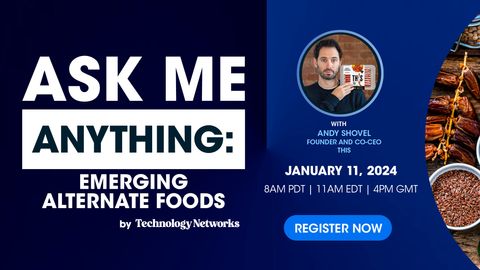Discover Emerging Alternate Foods With Andy Shovel
Is plant-based protein the sustainable meat replacement that we need?

Complete the form below to unlock access to ALL audio articles.
The future of food is rapidly evolving with the development of alternative protein sources. From plant-based proteins to cultured meat and insect-derived products, researchers are developing new food products that replicate or replace traditional animal-based proteins like meat, dairy and eggs.
Andy Shovel is CEO and co-founder of THISTM, a company pioneering advances in plant-based alternatives to meat. Andy is a respected entrepreneur and influential figure in the sphere of sustainable food innovation. He has been instrumental in driving the evolution of alternative food solutions and spearheading initiatives that redefine the way society approaches food consumption.
Technology Networks invited Andy to an Ask Me Anything session to answer your questions about the latest advances in alternate foods. These are just some of the questions that we asked, click below to watch the full AMA.
Alexander Beadle (AB): Can you give us an overview of how THISTM products are made?
Andy Shovel (AS): A lot of it depends on the specific product, but there are a lot of similarities across the production process. Essentially, we take protein that has been isolated from plants and turn it into a different format.
For example, we can take a pea and remove some of the bits we don’t need, this might be the husk on the outside and some fibrous filler. That leaves us with just the protein from the original pea. This is the type of protein that you might find in protein shakes or protein bars. We take that protein, and we add water to hydrate it, then we apply heat and pressure to create a different physical architecture. This creates long fibers that are like muscle tissue, which is closer to the structure of meat.
Once that process is finished, we can begin to add flavor using natural ingredients. That can be a challenging piece of work because these plant-based products don’t taste exactly how we want, they aren’t bland or tasteless – they taste mainly of peas. So, adding flavor to them is a difficult job, especially when we’re trying to avoid anything processed and only use naturally derived products, like garlic or onion powder. After that, the next steps will depend on the product, for instance with sausages we will put an algae-based skin around them to mimic the skin on pork sausages, or we might coat the product in breadcrumbs or batter.
AB: How do you create a product that is very similar to meat?
AS: That could be quite a long answer, but to summarize, we leverage the most cutting-edge and leading technology. When it comes to texture, flavor and fat systems, we try to innovate based on existing best practices. For example, when you consider a plant-based sausage, there are five key components that need to be as good as they can be for that sausage to be a compelling alternative to a pork sausage. That includes the skin, succulence, flavor, mouth feel and general texture.
If these five components are in place and well designed, alongside the overall appearance of the product, then you have a great product.
I’ve tried to summarize and limit it to the five key components, but when we sit down and do the work, the actual number can be closer to 50. But you need to break it down into that many individual pieces so that the project can be achievable.
Using this system, it can take one or two years to develop a single product. At THISTM, we don’t go to a factory that already makes plant-based sausages and say to them, “make us a sausage”. We develop everything from the ground up. We have a formidable research and development team in the company, made of over 20 scientists whose job it is to manage and look after all of these projects and develop our food.
AB: How many iterations of a product does it take to produce a finalized version?
AS: The boring answer is that it depends. At the beginning of the company, when it was just myself and Pete with a few external consultants, we were doing the R&D and we could have almost 2,000 iterations of a single product because we were novices in the field.
Now we have a more professional approach to R&D and we will generally have 150–200 iterations, so it is a massive 10-fold reduction. Even then, it is still a challenging process, taking soybeans or peas and trying to make them identical to pork sausages or streaky bacon. This can be incredibly difficult, so it’s unsurprising that it can take so many iterations before we get it right.
AB: Is there a way for future food solutions to work with traditional farming?
AS: I think there is. Hopefully there will be some crossover between future foods and traditional farming, for instance, people will switch from pastoral farms that raise animals to arable farms that produce crops.
It is somewhat dependent on the climate and soil conditions of where that person is farming, it might not be possible for them to easily change over. But we also need to consider that at the dawn of new energy sources, when we were replacing coal with cleaner energy, people were distressed and they were worried about what would happen to the coal industry. And people did lose their jobs and had a very difficult time after that happened. But as a society we need to ask ourselves, what is more important, a segment of workers losing their jobs or stopping the diary and meat industry? An industry which is, in my opinion, causing more suffering and pollution than any industry on the earth, more than transport or energy companies.
AB: Nutrition is a key concern for vegetarians and vegans. When it comes to manufacturing, do you consider nutrition when a product is developed?
AS: Definitely. From the beginning, we have often supplemented our products with vitamin B12 and iron because those are two of the things that you might lack when you don’t eat meat.
The other important component of nutrition is protein. Our range of products are very high in protein and, generally speaking, you won’t lose out on any protein by swapping to our plant-based sausages or chicken compared to having the meat version. The other things to consider when comparing nutrition values are fat, saturated fat and salt. In comparison to fattier meat products, such as sausages, burgers and bacon, our products have significantly less fat.
Some people claim that our products aren’t healthy, but that is only the case if you’re comparing them to an aubergine or a salad. It is very different when you compare them directly to the meat product that they’re trying to substitute. For example, you can’t compare our plant-based bacon to a bowl of ratatouille, you have to compare it to animal bacon, because that is what we are trying to substitute. When you do that, it is a night and day comparison in terms of health.
We have 5% fat, 2% saturated fat, and half the salt content. I think it’s important that people make fair comparisons between meat and plant-based versions when discussing nutrition.
AB: Have you noticed any recent shifts in consumer behavior since establishing the company?
AS: When we first started in 2019, people were bright-eyed and bushy-tailed about the vegan market. But now, I think largely due to press negativity, people are more skeptical about meat alternatives than they originally were.
People are worried about the amount of processing that is involved. That has taken the sheen off plant-based products for some people. However, the fundamentals are still relatively strong – if you compare it to before the COVID-19 pandemic, we’re 47% up as a market category. That hasn’t gone away because of any negativity in the press, it has slowed the growth, but that is all it has done – slowed.
Long term, I think the prospects are very good; around 63% of the British public are looking to reduce their meat and dairy intake. Those people are going to be looking for alternatives as they become more and more committed to that goal. There has been a shift, but we were always going to see a bit of an overcorrection from where we started. As a category, we exploded early on, and that level of growth wasn’t sustainable. There was always going to be a period of consolidation, leading to fewer manufacturers and brands in the market. From this point on looking forward, either this year or over the next year, I expect the growth to normalize and stay around 4–6 % for the next couple of years.
AB: What is the big goal for THISTM foods? Where do you see yourselves in 10 years?
AS: The general ambitions for the brand are to cross different categories, not just to replace meat but to produce other products that can help remove animals from the food system.
Our mission as a company is to force the world's livestock into retirement.
We want to be the go-to brand for non-vegans and vegans, but our main goal is to configure products for predominately non-vegans. Moving forward, being the brand of choice for the mainstream consumer in several countries across different categories would be a phenomenal outcome for us. Also, in terms of size, right now in terms of sales we’re at just over £20 million a year, but we want to become a £100 million revenue brand over the next few years.
Andy Shovel was speaking to Alexander Beadle, Science Writer and Editor for Technology Networks.
About the interviewee
Andy Shovel is CEO and co-founder of THISTM, a company that develops plant-based alternatives to meat. Before launching THIS, co-founders Andy Shovel and Pete Sharman ran a burger business called Chosen Bun, which they sold in 2016 after they realized the problems associated with meat consumption. After Andy and Pete had spent two years working to design their cutting-edge products, they launched THISTM in 2019.




